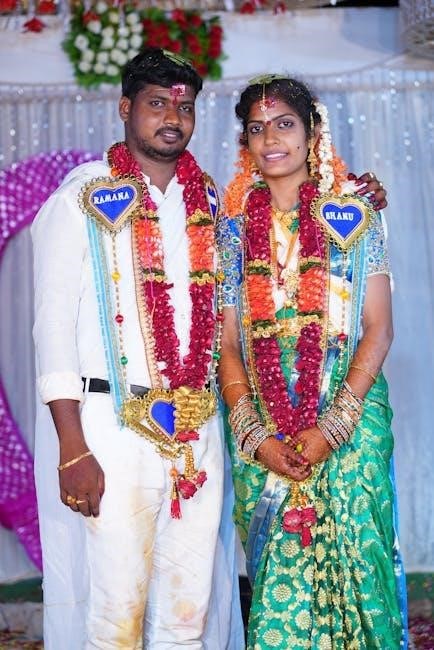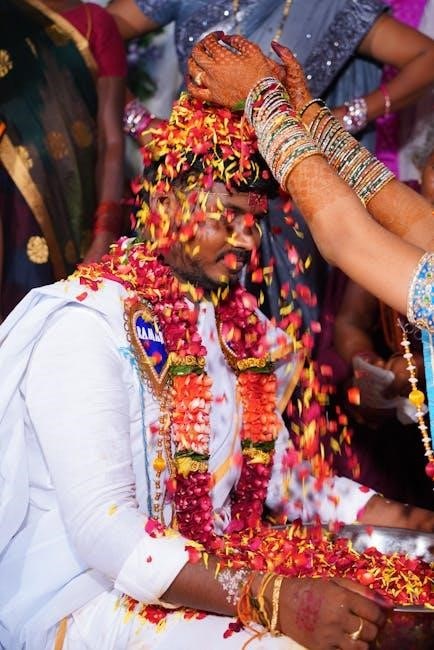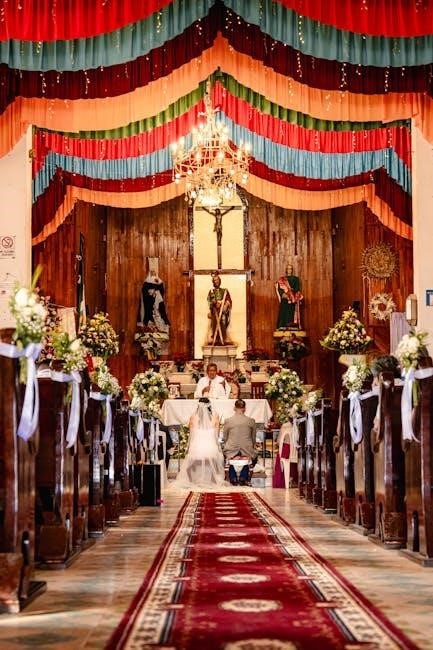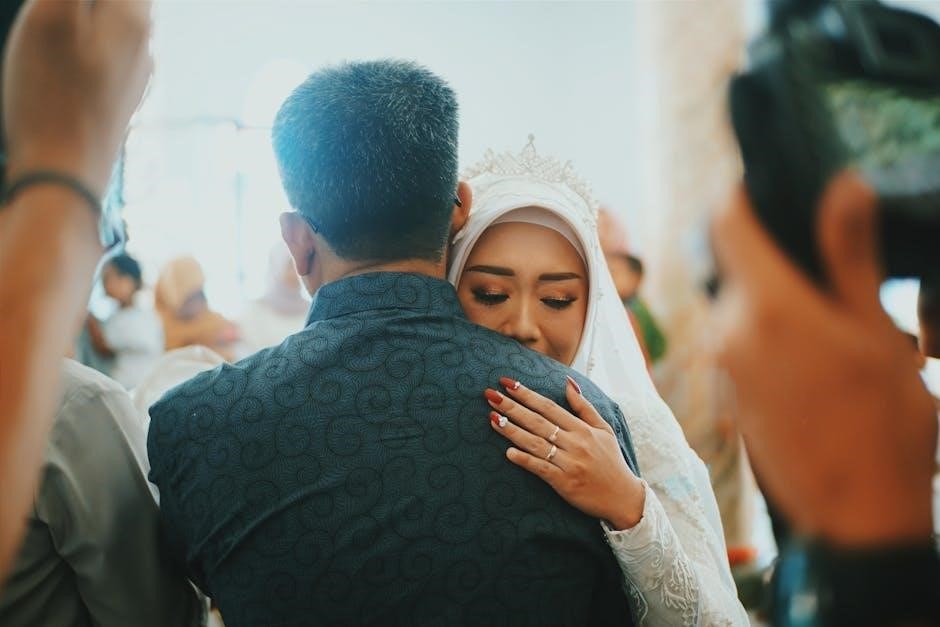
Non-religious wedding ceremonies emphasize personalization, allowing couples to celebrate their love and commitment without religious elements, offering flexibility and customization to reflect their unique journey and values.
1.1 Overview of Non-Religious Ceremonies
Non-religious ceremonies focus on personalization, allowing couples to express their commitment without religious elements. These ceremonies are flexible, emphasizing love, mutual respect, and shared values. They often include readings, music, and rituals that hold personal significance, creating a meaningful and intimate atmosphere. With no set script, couples can tailor the event to reflect their unique journey and beliefs, making it a heartfelt celebration of their union.
1.2 Importance of Personalization in Non-Religious Weddings
Personalization is key to non-religious weddings, allowing couples to reflect their unique journey, values, and love story. By incorporating meaningful rituals, readings, and music, the ceremony becomes a heartfelt reflection of their bond. This approach ensures the event feels authentic and tailored, creating a memorable experience for both the couple and their guests while emphasizing their commitment and individuality.
Structure of a Non-Religious Wedding Ceremony
A non-religious wedding ceremony typically follows a flexible, organized format, including a processional, welcome, vows, ring exchange, and pronouncement, all centered around the couple’s commitment.
2.1 Key Components of the Ceremony
The ceremony includes a welcome, processional, vows, ring exchange, and pronouncement, allowing couples to personalize each element while maintaining a meaningful structure that reflects their commitment and values.
2.2 Order of Events in a Typical Non-Religious Ceremony
A typical non-religious ceremony begins with a processional, followed by a welcome address, vows, and a ring exchange. The officiant then pronounces the couple married, concluding with a recessional. This structure ensures a meaningful and organized celebration while allowing for personal touches and customization to reflect the couple’s unique story and values.

Sample Non-Religious Wedding Ceremony Script
Downloadable PDF scripts offer customizable templates for non-religious ceremonies, including vows and ring exchanges, allowing couples to create a meaningful, personalized celebration of their commitment.
3.1 Generic Template for a Non-Religious Ceremony
A generic non-religious ceremony template includes a welcoming address, processional, vows, ring exchange, and pronouncement. It serves as a flexible starting point, allowing couples to add personal elements like readings or rituals. Downloadable PDF scripts provide structured yet customizable frameworks, ensuring a meaningful celebration tailored to the couple’s preferences and values.
3.2 Customization Options for the Script
Couples can personalize their ceremony by adding vows, unity rituals, or meaningful readings. Music, poems, and cultural elements can be incorporated to reflect their unique story. Downloadable PDF scripts often include customizable sections, allowing flexibility to tailor the ceremony to their preferences, ensuring a heartfelt and authentic celebration that truly represents their relationship and values.
Writing Vows and Ring Exchange
Heartfelt vows and the symbolic ring exchange are central to non-religious ceremonies, allowing couples to express their personal commitment and love, free from religious doctrine.
4.1 Tips for Writing Personal Vows
When crafting personal vows, speak from the heart, sharing anecdotes, promises, and aspirations. Be sincere, specific, and authentic, reflecting your unique relationship. Consider including how you met, what you cherish, and your vision for the future. Keep it concise, yet meaningful, ensuring your words resonate deeply with your partner. Optional: Add humor or poetry for a personal touch.
4.2 Significance of the Ring Exchange in Non-Religious Ceremonies
The ring exchange is a profound symbol of commitment in non-religious ceremonies, representing a timeless promise of love and unity. It serves as a visible reminder of the couple’s dedication to one another, transcending religious traditions. This act embodies the essence of partnership, making it a heartfelt and universal gesture in any wedding celebration.
Incorporating Personal Elements
Personal elements like unique vows, meaningful readings, and symbolic rituals add depth and authenticity to non-religious ceremonies, making them truly reflective of the couple’s love and journey together.
5.1 Readings, Music, and Rituals in a Non-Religious Context
Non-religious ceremonies often incorporate personalized readings, meaningful music, and symbolic rituals to create a meaningful atmosphere. Couples can choose poems, songs, or texts that resonate with their journey. Rituals like hand ceremonies or unity gestures add emotional depth, allowing the couple to express their commitment uniquely while reflecting their personal values and love story without religious elements.
5.2 Creating a Unique and Meaningful Ceremony
Non-religious ceremonies offer endless opportunities for personalization, allowing couples to craft a unique and meaningful experience. Incorporating personalized readings, symbolic rituals, and meaningful music enables couples to express their love and commitment in ways that reflect their individuality and shared values. These elements create a memorable and heartfelt celebration that truly represents their personal journey and bond.

Role of the Officiant
The officiant guides and celebrates the union, creating a meaningful script that reflects the couple’s unique story and values, ensuring a personalized and memorable ceremony.
6.1 Choosing the Right Officiant for a Non-Religious Ceremony
Selecting the right officiant is crucial for a non-religious ceremony, as they set the tone and ensure the script aligns with the couple’s vision. They may be a friend, family member, or professional, but should resonate with the couple’s values and style. A personalized approach ensures the ceremony feels authentic and meaningful, reflecting the couple’s unique journey and commitment to one another.
6.2 Responsibilities of the Officiant in a Non-Religious Setting
The officiant’s role in a non-religious ceremony is to guide the proceedings, ensuring a meaningful and personalized experience. They oversee the flow of events, pronounce the couple married, and handle legal requirements. The officiant also works closely with the couple to craft a ceremony script that reflects their values and love story, creating a memorable and authentic celebration.

Legal Considerations
Ensuring legal recognition involves proper documentation, witness signatures, and an authorized officiant. Couples must comply with local marriage laws to validate their non-religious ceremony officially.
7.1 Ensuring the Ceremony is Legally Recognized
To ensure a non-religious wedding ceremony is legally recognized, couples must obtain a marriage license, have an authorized officiant perform the ceremony, and ensure proper documentation. Witnesses must sign the marriage certificate, and the officiant must submit the completed document to the relevant authorities. Adhering to local marriage laws guarantees the ceremony’s legal validity and provides a formal record of the union.
7;2 Necessary Documentation and Witnesses
For a non-religious wedding to be legally recognized, couples must complete and sign a marriage certificate in the presence of at least two witnesses, typically aged 18 or older. The officiant must also sign and submit the document to the appropriate authorities. Proper documentation ensures the union is legally binding and provides an official record of the marriage.
Unity Ceremonies and Rituals
Unity ceremonies, like handfasting or candle lighting, symbolize the joining of two individuals, creating a meaningful and personalized moment that reflects their commitment and bond.
8.1 Popular Unity Rituals in Non-Religious Weddings
Popular unity rituals include hand ceremonies, candle lighting, and tree plantings. These symbolic acts represent commitment and unity, offering meaningful ways to celebrate the couple’s bond without religious elements. Each ritual can be personalized to reflect their unique journey and values, creating a memorable and heartfelt moment during the ceremony.
8.2 Symbolism and Meaning Behind Unity Ceremonies
Unity ceremonies symbolize eternal commitment and togetherness. Rituals like candle lighting or hand ceremonies represent the merging of two lives into one. These acts often signify strength, unity, and mutual support, offering a meaningful way to celebrate the couple’s bond. Personalization allows couples to infuse rituals with personal significance, creating a profound and lasting memory in their non-religious ceremony.
Resources for Non-Religious Wedding Scripts
Discover downloadable PDF scripts and templates for non-religious ceremonies online. Websites offer free samples, customizable templates, and guides to create a personalized, meaningful wedding ceremony.
9.1 Where to Find Non-Religious Ceremony Scripts
Non-religious ceremony scripts are widely available online. Websites like American Marriage Ministries, wedding planning platforms, and PDF repositories offer free downloadable scripts. Couples can explore libraries of templates, sample scripts, and customizable options to suit their preferences. Many resources provide guides for personalization, ensuring a unique and meaningful ceremony. These platforms cater to diverse styles, making it easy to find or create the perfect script.
9.2 Downloadable PDF Scripts and Templates
Downloadable PDF scripts and templates for non-religious ceremonies are readily available online. Many websites offer customizable templates, including marriage and civil partnership scripts. These PDFs provide structured outlines with space for personal vows, readings, and rituals, allowing couples to tailor the ceremony to their preferences. They are easy to access and print, making ceremony planning efficient and stress-free.
A non-religious wedding ceremony script PDF offers flexibility and personalization, empowering couples to create a meaningful celebration of love and commitment without religious elements, ensuring a unique and memorable experience.
10.1 Final Tips for Planning a Memorable Non-Religious Wedding
Personalize your ceremony with meaningful rituals, readings, and vows. Choose an officiant who aligns with your values. Stay flexible and enjoy the process. Ensure all legal requirements are met. Incorporate personal stories and symbols to make the ceremony uniquely yours. Focus on creating a heartfelt, authentic celebration that reflects your love and commitment. Remember, the goal is to make the day unforgettable and deeply personal.
10.2 Encouragement to Personalize and Make the Ceremony Your Own
Embrace the freedom to craft a ceremony that truly reflects your love story. Incorporate personal vows, meaningful readings, or unique rituals that hold special significance for you both. Celebrate your journey and values with authenticity, ensuring every moment feels uniquely yours. This is your chance to create an unforgettable, heartfelt celebration that honors your commitment and connection.